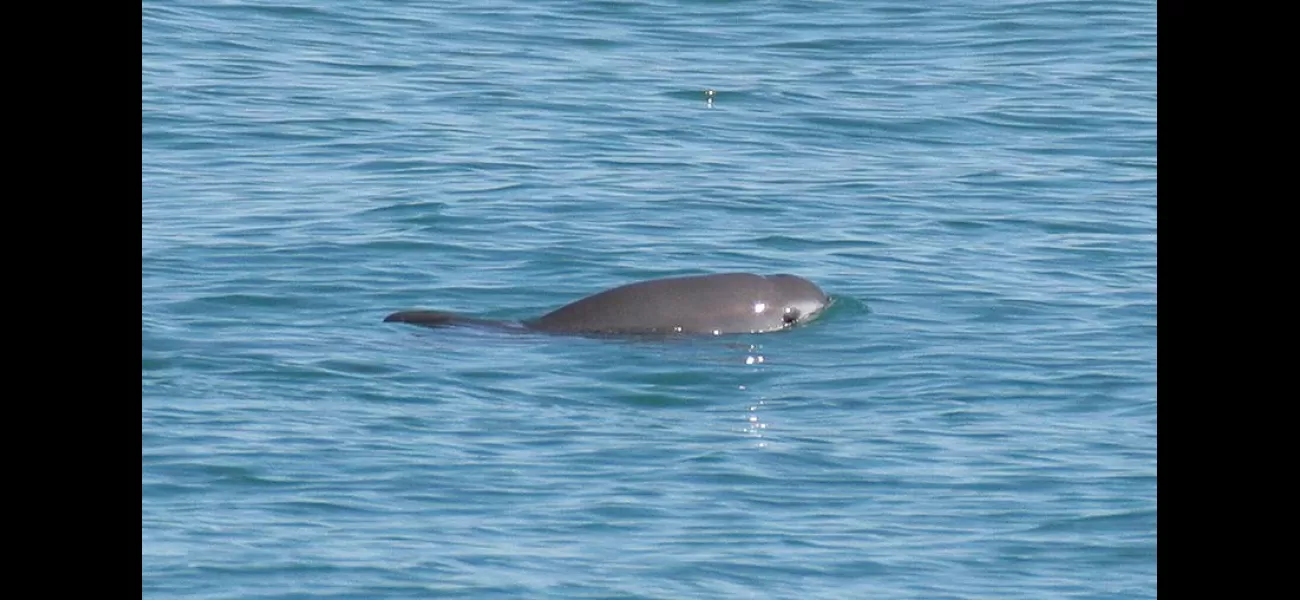The world's rarest sea animal is in danger as time is running out.
They are close to a critical point.
July 6th 2024.

The vaquita, a small porpoise found in the upper Gulf of California in Mexico, is in grave danger of extinction. Despite being the world's most endangered sea mammal, many people are unaware of its existence. Sadly, the population of vaquitas has dwindled to a mere handful of individuals.
With just five feet in length, these tiny creatures have captured the hearts of researchers and marine biologists alike. However, the latest annual survey revealed a distressing truth - only six to eight vaquitas were seen, a significant decrease from the previous year's count of eight to thirteen. To make matters worse, no new calves were spotted, except for one thriving yearling born in 2023.
The vaquita, the smallest member of the cetacean family, was only discovered in the 1950s when marine biologist Kenneth Norris stumbled upon a skull washed up on the beach. These elusive creatures are often found in pairs, spending most of their time hidden beneath the waves. This secretive nature has made it difficult for humans to observe them and track their population.
The vaquita's habitat is limited to the warm waters of the Gulf of California, making them vulnerable to getting caught in gillnets - long nets used for catching fish. Unfortunately, many of these gillnets are illegally set to capture the totoaba, a fish highly sought after in China for its swim bladders. Driftnets used for catching blue shrimp also pose a threat to the vaquitas. In response to this, the Mexican government has established a protected area known as the Zero Tolerance Area, where fishing is strictly prohibited in hopes of saving the species.
The vaquita may be small, but it has a fascinating history. It is believed to have descended from Burmeister's porpoise, found off the coasts of Peru, Chile, and Argentina. During a period of global cooling, a group of these porpoises swam up the Gulf of California. When the waters warmed up again, they were unable to return and instead evolved into their own distinct species.
The team searching for vaquitas, led by vaquita charity Sea Shepherd, focused their efforts on the Zero Tolerance Area. However, half of the sightings were outside this protected zone, indicating the urgent need for further protection measures. Dr. Barbara Taylor, the leader of the survey, expressed concerns over the results and emphasized the importance of extending the survey using acoustic detection to determine the vaquitas' whereabouts. She also stressed the need for protecting vaquitas outside the sanctuary from ongoing gillnetting.
The survey was conducted using underwater acoustic listening devices to locate the animals, followed by visual surveys by experienced observers on board two boats. The team plans to continue the survey until July and August to gather more data on the vaquitas. The future of these precious creatures depends on the efforts of researchers and conservationists to protect their habitat and prevent their extinction.
With just five feet in length, these tiny creatures have captured the hearts of researchers and marine biologists alike. However, the latest annual survey revealed a distressing truth - only six to eight vaquitas were seen, a significant decrease from the previous year's count of eight to thirteen. To make matters worse, no new calves were spotted, except for one thriving yearling born in 2023.
The vaquita, the smallest member of the cetacean family, was only discovered in the 1950s when marine biologist Kenneth Norris stumbled upon a skull washed up on the beach. These elusive creatures are often found in pairs, spending most of their time hidden beneath the waves. This secretive nature has made it difficult for humans to observe them and track their population.
The vaquita's habitat is limited to the warm waters of the Gulf of California, making them vulnerable to getting caught in gillnets - long nets used for catching fish. Unfortunately, many of these gillnets are illegally set to capture the totoaba, a fish highly sought after in China for its swim bladders. Driftnets used for catching blue shrimp also pose a threat to the vaquitas. In response to this, the Mexican government has established a protected area known as the Zero Tolerance Area, where fishing is strictly prohibited in hopes of saving the species.
The vaquita may be small, but it has a fascinating history. It is believed to have descended from Burmeister's porpoise, found off the coasts of Peru, Chile, and Argentina. During a period of global cooling, a group of these porpoises swam up the Gulf of California. When the waters warmed up again, they were unable to return and instead evolved into their own distinct species.
The team searching for vaquitas, led by vaquita charity Sea Shepherd, focused their efforts on the Zero Tolerance Area. However, half of the sightings were outside this protected zone, indicating the urgent need for further protection measures. Dr. Barbara Taylor, the leader of the survey, expressed concerns over the results and emphasized the importance of extending the survey using acoustic detection to determine the vaquitas' whereabouts. She also stressed the need for protecting vaquitas outside the sanctuary from ongoing gillnetting.
The survey was conducted using underwater acoustic listening devices to locate the animals, followed by visual surveys by experienced observers on board two boats. The team plans to continue the survey until July and August to gather more data on the vaquitas. The future of these precious creatures depends on the efforts of researchers and conservationists to protect their habitat and prevent their extinction.
[This article has been trending online recently and has been generated with AI. Your feed is customized.]
[Generative AI is experimental.]
0
0
Submit Comment





